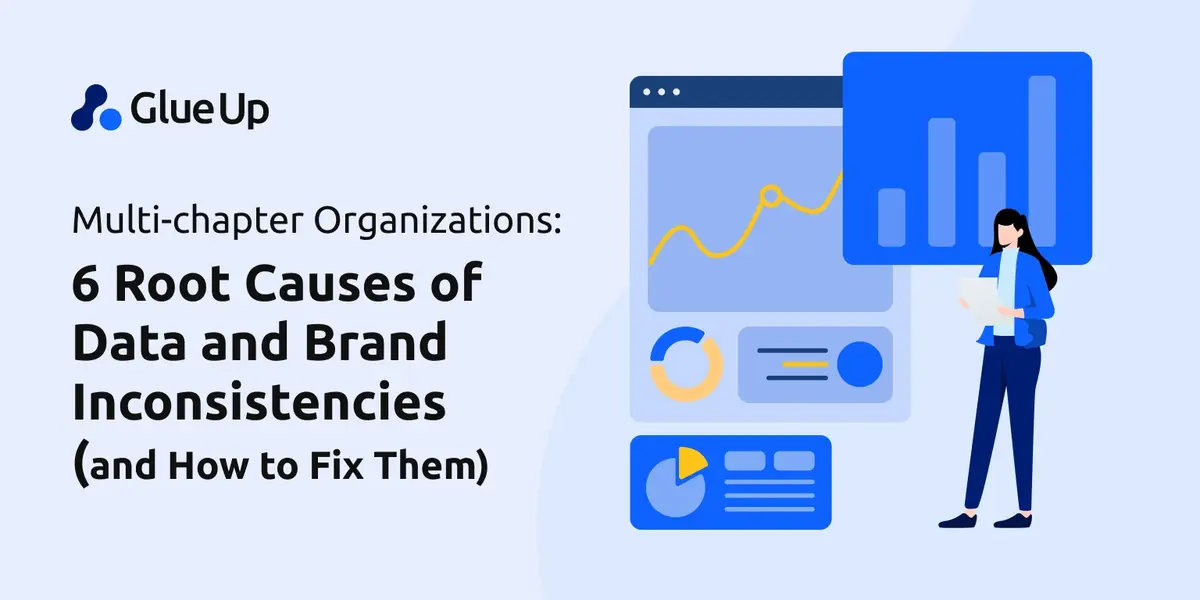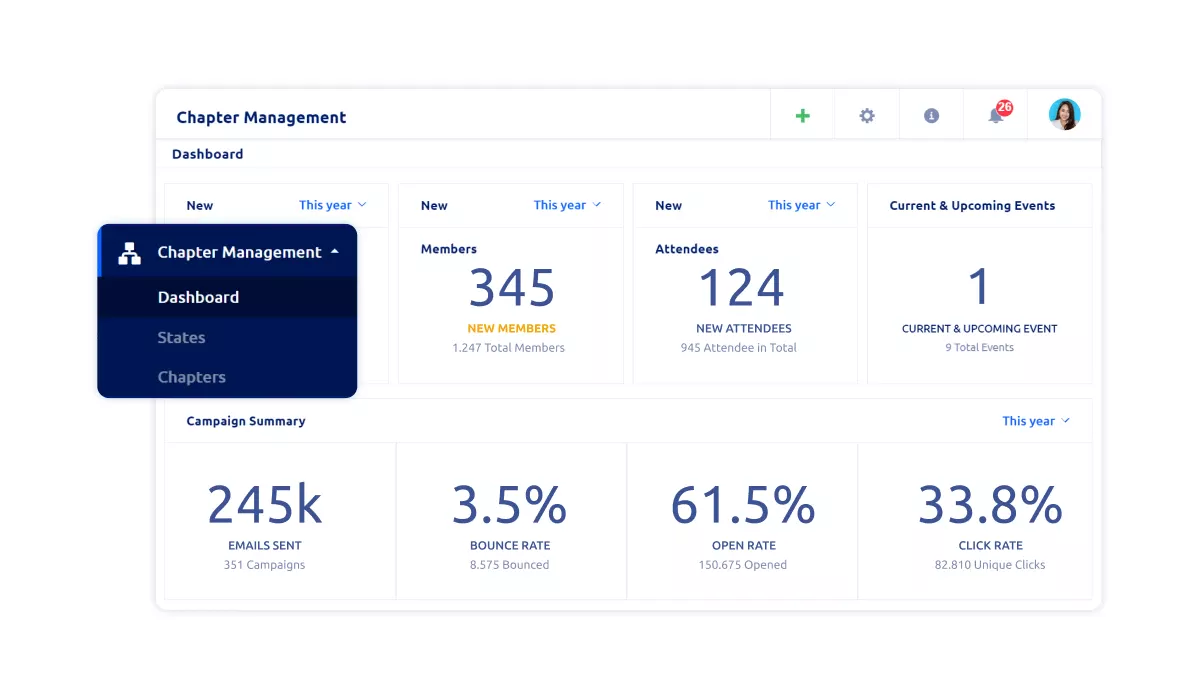
Inconsistent data and branding can cause significant issues for multi-chapter organizations.
Your chapters and affiliates may collect data in different ways at different levels, resulting in discrepancies and inconsistencies. Moreover, if your association lacks a clear brand voice, it won't stand out to your members.
To make sure that you're covering all the bases, we’ve outlined six root causes of data and brand inconsistencies in multi-chapter organizations. We will also explore their negative impacts along with effective strategies and tools to fix them.
Quick Reads
- The Prime Causes of Brand and Data Inconsistencies in Multi-Chapter Organizations
- What Are The Negative Impacts of Inconsistent Data and Branding in Chapter-Based Organizations?
- Strategies to Ensure Consistency across Multi-Chapter Organizations
The Prime Causes of Brand and Data Inconsistencies in Multi-Chapter Organizations
Reason # 1 - Lack of Centralized Brand Guidelines
In the absence of centralized branding guidelines, each chapter is free to develop its own logos, taglines, and marketing materials, resulting in inconsistency.
As more chapters and partners join your organization, your brand identity can get out of your hands. As a result, your team may lose sight of your core brand guidelines, resulting in inconsistent messaging.
Let’s take a simple example of this. Chapters and affiliates in other regions or countries may interpret brand guidelines according to their aesthetic or cultural values. While this can give your branding a unique feel, it can also cause your potential members to doubt their authenticity.
Reason # 2 - Ineffective Communication

Data and brand inconsistencies can also be attributed to poor communication.
Without clear communication channels and shared goals, each chapter may develop its own approach to collecting and analyzing data, which can result in inconsistencies in the way data is presented and interpreted.
In some cases, disconnection can also lead to duplication of effort. For example, if two chapters are collecting the same data but using different methods or systems, it can result in inconsistencies in the data and wasted resources.
Lastly, when communication is inconsistent across chapters, it can dilute the brand's messaging and weaken your overall impact. Thus, your members may receive conflicting messages from different chapters, leading to confusion and a lack of trust in the brand.
Reason # 3 - Different Target Audiences

What resonates with one audience might not resonate with another.
If your chapters target different audiences, they may focus on different goals, priorities, and messages. Though they may have messaging, branding, and data collection tailored to their specific audience, it can lead to discrepancies and inconsistencies across the organization as a whole.
Reason # 4 - Different Data Platforms
With data spread across multiple platforms, comprehensive analysis becomes very challenging. This makes it harder to identify trends, patterns, and insights for decision-making and strategic planning.
It also creates barriers to effective communication and collaboration between chapters, making it more difficult to share best practices, resources, and knowledge between them.
Also, the use of multiple data platforms can make it difficult to comply with data protection regulations and ensure data security. Each software has its own policies, procedures, and security measures, which makes it hard to guarantee the security of data across your organization.
Reason # 5 - Lack of Training
Proper training is essential for understanding your association’s data management policies and procedures. Unless you provide your chapter team with adequate training, it may be difficult to collect, store, and report data efficiently, leading to inconsistencies and errors.
If employees at different chapters of your organization are not trained in brand and data management, they might not understand the importance of consistency or how to achieve it.
Also, a lack of training can result in weak communication skills, leading to misinterpretation or miscommunication of information between chapters which can further contribute to inconsistencies.
Reason # 6 - Lack of Accountability
Poor communication between chapters can lead to misunderstandings and misinterpretations of brand guidelines and data management policies. This might result in each chapter following its own set of rules, leading to inconsistencies in brand representation and data handling.
When decisions regarding brand and data management are made independently by each chapter, there is an increased risk of inconsistencies. The lack of a centralized decision-making process can lead to varying interpretations of brand guidelines and data management practices, causing discrepancies.
What Are The Negative Impacts of Inconsistent Data and Branding in Chapter-Based Organizations?
Inconsistent data and branding can have significant negative impacts on multi-chapter associations. For example, data inconsistencies can lead to inaccurate reporting, making it difficult to assess the organization accurately.
Inconsistent branding can also lead to confusion among members and stakeholders. Without a consistent brand identity, it can be difficult to establish a clear vision or message for the organization.
It may also result in missed opportunities to attract new members, sponsors, or donors who do not know what the organization is all about or for whom it is valuable.
Strategies to Ensure Consistency across Multi-Chapter Organizations
If your multi-chapter organization is struggling with inconsistencies in its data and brand, here are a few strategies you can use to combat them.
Centralize Data Collection and Management

One effective strategy is to centralize data collection and management. You can accomplish this through a combination of technology, processes, and policies.
Begin by outlining a comprehensive data management strategy that defines the organization's objectives, data requirements, and key performance indicators (KPIs) to measure success.

Choose a centralized database or data management platform that allows for easy access, storage, and retrieval of information across chapters. Multi-chapter association management platforms are often preferred for this task as they are scalable, accessible, and capable of real-time data synchronization.
Lastly, establish data validation rules and quality control procedures to maintain the integrity of the data collected. This may include regular audits, data cleansing, and error resolution processes.
Create a Brand Bible and Provide Training
Another strategy is to establish a brand bible and provide training to all chapters.
Your brand guidebook should have clear guidelines for logos, fonts, color schemes, and messaging. Provide training on how to use the guidebook to ensure that all chapters are keeping up with your branding.
Implement a System for Monitoring Compliance
Implement a compliance monitoring system so that all chapters adhere to established standards for data and branding.
For example, the unified dashboard in multi-chapter management software automatically transfers data from chapters and affiliates to your regional or national headquarters. Thus, it provides a bird’s-eye view of all your chapter’s operations and monitors their health.
Use Technology to Streamline Processes

You are missing out big time if you are not using technology to streamline your chapter workflows.
Chapter management software is one such digitalization platform that allows multi-tier organizations to ensure consistency in their operations and branding. It allows you to track and coordinate your chapters’ activities through a centralized CRM.
You can store and manage essential data, such as member information, financial records, and event data, in the central database. The best part of this solution is that it ensures consistent branding across your entire association through a branded mobile app and a consistent web presence for each branch.
If you are interested in learning more about the software, get a free demo.
Encourage Communication and Collaboration
Finally, take steps to encourage communication and collaboration among chapters.
Organize regional or national meetings, workshops, and conferences where chapter leaders can network, share best practices, and learn from each other.
Create online forums and discussion groups where chapter leaders can ask questions, share experiences, and seek advice from their peers. Pair newer or less active chapters with more experienced ones to encourage knowledge sharing.
Lastly, foster a sense of unity and shared purpose among chapters by emphasizing the importance of collaboration and communication in achieving the association's mission and vision.
Inconsistent data and branding among chapters can create significant challenges for your association. However, with the right strategies, technology, and execution, you can ensure data and brand integrity across your multi-tier organization.
If you have further questions about ensuring uniformity and managing the disconnect between your chapters, please feel free to contact us here.



